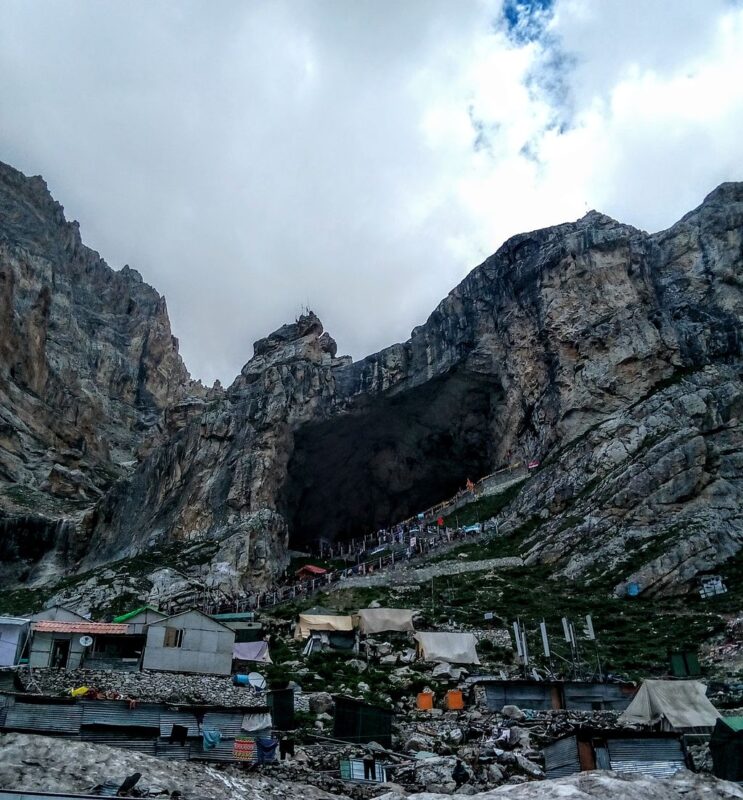Amarnath Cave
High in the Himalayas, Amarnath Cave is home to a naturally forming Shiv Linga, attracting thousands of pilgrims each year on a challenging but spiritually rewarding journey.

Amarnath Cave: Spiritual Significance and Pilgrimage Guide
| Deity: | Swayambhu lingam of Lord Shiv |
| State – City: | Anantnag district of Jammu and Kashmir |
| Best time to visit | Jul-Aug |
| Open Hours | 6:00 AM – 6:00 PM |
| Popular festival | Maha Shivaratri |
FAQ
Where is Amarnath Cave located?
Pahalgam tehsil of the Anantnag district of Jammu and Kashmir
What is the history and significance of the Amarnath Cave?
The Amarnath Cave is a revered pilgrimage site in Jammu and Kashmir with a history that dates back to ancient times. The cave is believed to have been discovered by a shepherd named Buta Malik in the 15th century. However, references to the cave can be found in ancient texts like the Nilamata Purana and the Mahabharata. According to legend, Buta Malik was given a sack of coal by a holy man, which turned into gold, leading to the discovery of the cave. Over the centuries, the cave has become a significant pilgrimage destination for Hindus.
What is the significance of the naturally forming ice stalagmite in the Amarnath Cave?
The Amarnath Cave houses a naturally forming ice stalagmite, revered by Hindus as a Shiva Linga. This Shiva Linga waxes and wanes with the phases of the moon and is considered a sacred symbol of Lord Shiva. The annual Amarnath Yatra, which takes place during the summer months of July and August, attracts thousands of devotees who come to pay homage to Lord Shiva.
What is the legend associated with the Amarnath Cave and Lord Shiva?
According to Hindu mythology, the Amarnath Cave is the place where Lord Shiva revealed the secret of immortality (Amar Katha) to Goddess Parvati. To ensure that no one else heard the secret, Shiva created a fire to destroy all life forms around the cave. However, an egg hidden under the deer skin on which Shiva sat remained protected. From this egg emerged a pair of pigeons, who became immortal after overhearing the secret. Devotees often report seeing pigeons in the cave, believed to be the descendants of these divine birds.
What are the geographical details and altitude of the Amarnath Cave?
The Amarnath Cave is situated at an altitude of approximately 3,888 meters (12,756 feet) above sea level in the Himalayas. The cave itself is about 40 meters high, with the Shiva Linga typically forming to a height of about 10 to 12 feet. The cave is surrounded by snow-covered peaks and is only accessible during the summer months when the weather conditions are favourable.
How long does the Amarnath Yatra trek take, and what are the challenges?
The trek from Pahalgam covers a distance of approximately 45 km and typically takes about 3-5 days. The Baltal route is shorter, covering about 14 km, but it is much steeper and can be completed in a day. The pilgrimage route passes through rugged terrain, snow-capped peaks, and glacial streams, making it a challenging yet spiritually fulfilling journey. The challenges faced include unpredictable weather, the risk of altitude sickness, and the physically strenuous nature of the trek.
What are the major stops and places along the Amarnath Yatra route?
The Amarnath Yatra has two main routes:
- From Pahalgam Side:
- Pahalgam: The traditional base camp for the pilgrimage, located about 96 km from Srinagar.
- Chandanwari: The first major stop after Pahalgam, known for its scenic beauty.
- Pissu Top: A challenging climb with a legend of a battle between gods and demons.
- Sheshnag: A site named after the mythical serpent Sheshnag, featuring a beautiful lake.
- Panchtarni: The last stop before reaching the Amarnath Cave, named after the confluence of five rivers.
- From Baltal Side (Sonmarg):
- Baltal: A shorter but steeper route compared to Pahalgam, located about 14 km from the cave.
- Domail: The first major stop from Baltal, where pilgrims can rest and gather supplies.
- Barari Marg: An important rest stop offering picturesque views.
- Sangam: The confluence point where the Baltal and Pahalgam routes meet, leading to the final ascent to the Amarnath Cave.
What legal permits are required for the Amarnath Yatra, and what precautions should be taken?
Pilgrims must register with the Shri Amarnath Shrine Board to undertake the Amarnath Yatra. This involves obtaining a Yatra Permit, which requires a compulsory health certificate to ensure fitness for the trek. Pilgrims must also carry valid photo identification. Adequate preparation, including physical fitness training and acclimatization, is essential for a safe and successful pilgrimage.
The Amarnath Cave pilgrimage is not just a physically challenging journey but also a deeply spiritual experience. With its ancient history, mythological significance, and breathtaking natural beauty, the Amarnath Yatra remains one of the most revered pilgrimages in Hinduism. Pilgrims undertaking this sacred journey are encouraged to prepare adequately and approach the trek with reverence and devotion.







